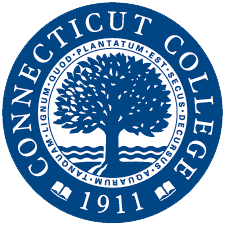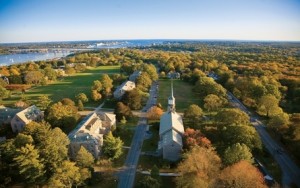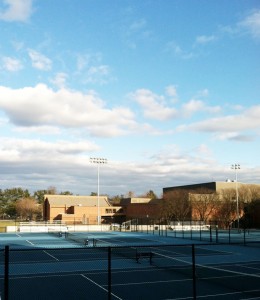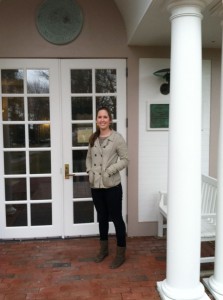By Sue Luse and Lindsay Berg, Class of 2003
Location/Overview
Perched atop a hill overlooking Long Island Sound and the Thames River, Connecticut College cherishes its small class sizes, honor system and dedicated professors. Separated from downtown New London on a hilltop originally considered to be “the finest college site in the world,” Conn College (as it is commonly referred to) is its own little slice of New England. Students wander across the grounds, stroll through the 750-acre arboretum, live and study in Gothic and Georgian style buildings, utilize state of the art academic and athletic facilities, and compete in the NESCAC conference. It is two hours away from New York and Boston. With its close proximity to Providence, New Haven, and several quaint New England towns, students find themselves with ample opportunity to explore the East Coast.
History
Founded in 1911 after Wesleyan decided to deny entry to women, Conn originally opened as a women’s college and became co-ed several decades later in 1969. Known as one of the “little ivies,” Conn prides itself on educating “Students to put the liberal arts into action as citizens in a global society.”
Academics
Connecticut College students find themselves in small classes where discussion, dialogue and writing play key roles in academics. Professors engage their students, include them in research, and act as mentors and friends. Moreover, professors support student independence, and self-designed research and independent studies are commonplace. This focus on individualized thought has led Conn to produce more Fulbright Scholars than any other Liberal Arts School in the country. Conn is strong in the humanities, sciences, and arts, and to help craft a well-rounded education, students are required to take seven courses from a wide area of disciplines. First year students also enroll in a freshman seminar year, and Conn’s incredible CELS (Career Enhancing Life Skills) program provides funding for all students to pursue internships during the summer between their junior and senior year.
Connecticut College’s honor system dictates all walks of life on campus, and it fosters Conn’s open and friendly environment. Based on trust and mutual respect, Conn students created the code in 1922. At Conn, exams are self-scheduled and are not proctored; this allows students to take their finals when confident and ready, and students and professors trust one another to be ethical and respectful.
Recreation
Connecticut College does not have a Greek system, instead students find themselves awash in activities ranging from Capella group concerts, dances, theater, renowned speakers, art trips to New York City, outings to Harkness Beach, boat trips to Block Island, ice cream and pizza in neighboring town Mystic, Camelympics (dorm wars), and Floralia (a day-long spring music festival).
Quick Facts
- Student-faculty ratio is 9:1
- Average class size is about 19
- 50% of students receive financial aid
- Submission of standardized tests is optional in the admission process
- More than 40 majors
- 178 full-time professors; 90 percent hold a doctorate or equivalent
- Strong interdisciplinary programs, including five interdisciplinary academic centers
- 1,900 students from 45 states, Washington, D.C., and 71 countries; 40% men, 60% women; 16.4% domestic students of color; 12% students with an international background
- Highly selective, residential, co-educational
- Housing is provided all four years on campus
- Member of NESCAC: the New England Small College Athletic Conference
- NCAA Division III
- Being environmentally conscious plays an important role at Conn College; the school composts, has its own garden, purchases green energy and has a comprehensive recycling program to reduce its ecological footprint
- A national reputation for outstanding service-learning programs and community partnerships
- Pre-law, pre-business and pre-med programs. In recent years, the acceptance rate for our seniors applying to law school and graduate programs in the health professions is about 80 percent.
- Brand new $20 million state of the art facility for life sciences and computer science.





